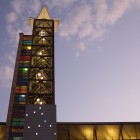Background
LEED, or Leadership in Energy and Environmental Design, is a certification system that rates buildings for their environmental efficiency. The U.S. Green Building Council developed the program in 2000, and it has since gained international regard. LEED measures a variety of metrics, including the site where a building is constructed, water efficiency and indoor environmental quality. Buildings must earn at least 40 of 110 possible points to achieve the lowest level of certification. 80 points or more earns a building platinum certification.
Many types of buildings are eligible to seek LEED certification, including offices, retail spaces, schools and apartment complexes. Some private homes may also qualify. The City of Austin frequently pursues LEED ratings for its buildings. Austin City Hall earned a gold rating in 2006, and many other city projects have earned high marks from LEED. The University of Texas at Austin got its first LEED certification in March 2007 for a facility at the J.J. Pickle Research Center. The university will seek LEED certification in all current and future building projects, according to its 2011 Green Report Card.
LEED has received criticism from some architects, policymakers and others in the building industry. Architect Frank Gehry told PBS that LEED certification is “complicated” to achieve, says little about a building’s sustainability but does much for public relations. Mechanical designer Henry Giffords identified four sins of LEED, noting that LEED buildings often use up to 29 percent more energy than non-LEED counterparts.
